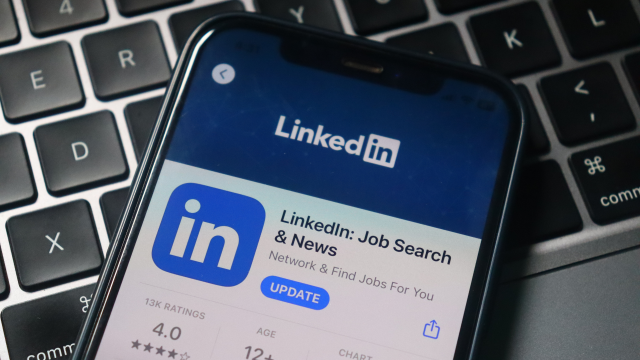Most LinkedIn users are probably familiar with the site’s longtime offerings, including job postings, the newsfeed, and congratulating people you met once at a conference on their work anniversary. But unless you spend a lot of time on the professional networking site, you may not be aware of some of its more recent additions, like the “I’m interested” button that some companies have on their profile.
How does the “I’m interested” button on LinkedIn work?
In short, the “I’m interested” feature allows users to privately express interest in working for a particular company without applying for a specific role. Think of it as the digital equivalent of sending your resume to a company with a note asking their hiring team to keep it on file and consider you for future job openings as they arise.
The “I’m interested” button is located on either the “About” or “Life” tabs of a company’s profile, or on the “About the company” section of individual job listings. If you can’t find it, the company either doesn’t have active LinkedIn Career Page and Recruiter contracts, or they’ve disabled the feature.
Once you’ve found and clicked the button, you become part of the company’s “Talent Interest Pipeline”—meaning that the next time their recruiters need to fill a role, they have the option of searching for qualified candidates who have already indicated that they want to work for the organization. The recruiters can view your profile and share it with other members of the hiring team, but that’s it. When you express interest in a company, it’s not visible on your public profile, LinkedIn’s newsfeed, or to any other companies or recruiters.
If your situation changes, you can withdraw your interest in a company at any time by returning to the location of their “I’m interested” button and clicking “undo;” otherwise, you’ll remain part of their Talent Interest Pipeline for one year.
When to use the “I’m interested” feature
By giving users more control over who can see that they’re looking for new opportunities, the “I’m interested” feature is a lower-stakes alternative to adding the “Open to Work” badge to their public profile, or even limiting its visibility to recruiters. But according to Matthew Warzel, the president of MJW Careers, how and when you use it matters.
LinkedIn markets the tool to recruiters as a way to easily identify candidates who are not only interested in working for their company, but also possess the same values. So, before clicking or expressing interest in anything, Warzel—who has more than 15 years of experience in recruitment, outplacement, and career coaching—recommends looking into a company to make sure that its values align with yours, and that it’s a good match for your career goals and skills.
This also matters because LinkedIn users are limited to expressing interest in up to 50 companies. “It’s crucial to reserve this feature for organizations that are top priorities,” Warzel says. “Job seekers should focus on companies where they genuinely see themselves thriving and progressing in their careers.”
Here are some other tips for using the feature, courtesy of Warzel:
- DO click the “I’m interested” button proactively before formally applying for a position at a company. “It allows job seekers to stand out from the competition and potentially get noticed by recruiters earlier in the hiring process,” he says.
- DON’T wait for a job opening to signal interest in a company. “You might be a good fit for a future, unadvertised role the company might be creating,” Warzel says. “By expressing interest, you’re in the pool for potential consideration.”
- DO take the time to ensure that your profile is up-to-date and aligns with a company’s values and needs.
- DO use the feature to improve your overall experience. “LinkedIn’s algorithm takes into account the companies you’ve expressed interest in when suggesting connections and job opportunities,” he says. Signaling interest in unrelated or less desirable companies could also skew these recommendations.
- DON’T go overboard. According to Warzel, excessive use of the “I’m interested” feature—especially without tailored follow-up actions or research—may convey a sense of desperation to recruiters or hiring managers.
- DO click “I’m Interested” after connecting with someone at the company. “It strengthens your connection, shows you’re serious about exploring opportunities, and allows for a more targeted approach when reaching out to recruiters at a company directly,” Warzel says.
- DO prioritize companies strategically. “In highly competitive industries or job markets, job seekers may opt to save their ‘I’m interested’ slots for companies where they have a higher chance of standing out or securing an interview,” he says.
Ultimately, if you’re not putting the necessary time and effort into your job search, clicking “I’m interested” 50 times won’t magically make offers materialize. But when you’re attempting to stand out in a sea of qualified candidates and get your resume in front of the right person, you might as well take advantage of the tools at your disposal. “Remember: The button is just one piece of the puzzle,” Warzel says. “Following the company, engaging with their content, and directly reaching out to recruiters all work together to create a more comprehensive impression.”

Leave a Reply
You must be logged in to post a comment.